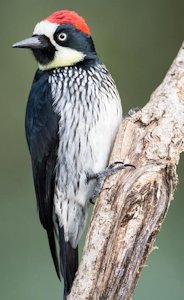
|
Bird Communal Breeding - Page 1 Picture this scene at a large valley oak in the coastal woodlands of California near Monterey. A female Acorn Woodpecker comes out of a nest hole in a dead snag, a large, whitish oval egg in its bill. Calling, the bird flies to a nearby tree and places the egg in one of thousands of small holes patterned along the trunk of the tree. Another woodpecker flies to join her, and then three more arrive, all calling loudly. One bird breaks open the egg and the group consumes its contents.The female then returns to its nest hole. Within a few hours the female has laid an egg of its own in the nest. This scene regularly occurs each year in the social life of the Acorn Woodpecker, one of the few communal-breeding birds of North America. The small holes in the tree trunk are hole the woodpecker made to store acorns for the winter. The egg the female was carrying was laid by one of the group-mates, who does the same to the female's newly laid egg. They trade back and forth like this for several rounds, until at last they stop eating the eggs and start incubating them. The egg-eating is probably prompted by competition among females, but the control of this behavior remains a puzzle to ornithologists. Return to Bird Mating Strategies On to Courtship Breeding Page 2 ⇨ |
| Male Acorn Woodpecker | |
|
Acorn Woodpeckers cooperate to raise their young. They live in groups of varying size, from 3 to 15 birds. Within the group, only one or two males mate and one or two females breed; the rest remain to help raise young, store food, and protect the group from predators and acorn thieves. |
|